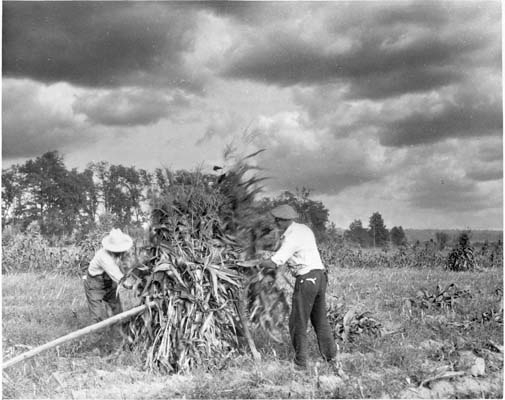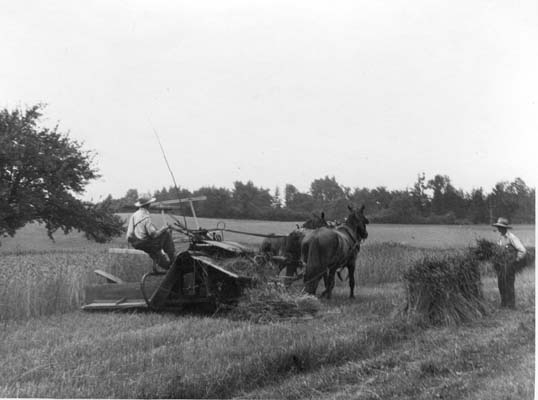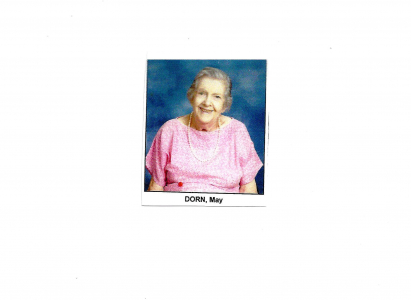Carl Sotherden* Reminisces on Harvesting Hay, Grain and CornPosted on March 14, 2012 |
Image

|
We continue with Carl’s memories: “As my brother and I grew, we soon were driving the horses on the hay fork with one driving the team and the other handling the hay rope and ‘whiffletrees’. The next move was driving the team on the hay loader, and as we stood on the front ‘gallus’ of the hay wagon, we could sometimes get pretty well packed in and also many hayseeds down our necks. Sometimes it seemed that a tough-bitted horse might pull our arms out of their sockets.”
“I well remember the time we stirred up a bees nest and the man loading the front end had to help us calm down the team or we might have had trouble. By this time, we were expanding our operations somewhat, helping our Grandfather who lived nearby, growing tobacco, cabbage, potatoes and hay as cash crops. It seems each year, we were learning to do new things and at certain jobs of light work, we could fill in for a man. A good example of this...later on one of us could set the hayfork for unloading hay while by then one of us could easily handle the team on the hay rope. By this time, our Grandfather was getting older and took over the transfer tasks while we graduated into more physical labors.”
“I might relate the changing methods that took place while I was growing up. The hay was cut by a horse-drawn mower with a five foot cutter bar, raked with a dump rake into windrows. It was then ‘cocked up’ to cure for a few days before being pitched by hand on a hay rack, hauled to the barn, and unloaded in the hay mow. As soon as I was large enough to reach the ‘hold down’ pedal and the dump pedal, I began to do some of the raking. Sometimes we used one horse and sometimes a team to draw the rake. By the time I was 11 or 12 years old, I had learned to mow and rake. My Dad fixed a foot rest on the mower so I had something to brace against to prevent being pulled off the seat as I drove the team. Generally, there was a man with another team and mower working along with me in care I ran into difficulties. This was spoken of later as ‘on the job training.’”
“Hay loaders hitched behind the hay wagons became a reality. Then the field bailer came along. One season we hired a neighbor to bale some of our hay and dump it on the ground. This was heavy workby hand so the next year we purchased a new field bailer with a chute to run the bales directly from the bailer on the hay rack and an elevator to run the bails into the mow. Bailed hay took much less room to store and we even bought standing hay to fill the barn. It took a larger business to meet the expenses of more machinery.”
“In the early days when the hay was handled loose, my Dad drew quite a bit to Syracuse to the livery stables, the firehouses and to the market gardeners in the Buckley Road area. One time, he was heading for Syracuse with a load on a set of ‘bobs’. He met some smarty coming north of the plank road with a load of lumber who vowed, ‘the ding dang farmers didn’t own the road’, and he wasn’t about to give him the right of way. So to avoid trouble, Father pulled off the plank road and over he went with the load of hay. Well, luckily, the load was bound tightly by both a hay binder and a log binder pole which held the hay onto the bobs. He unhooked his team and with one of the binder poles intact, he was able to get the loaded sleigh upright and proceed. Although, he did have to ride the rest of the way with the pole over one side as the load had shifted.”
“The oats and winter wheat that we grew for farm use were first cut by a drop reaper which had four wooden rakes to rake the cut grain off the wooden table in swaths. After laying out to dry, the grain was pitched with a tine long handled fork on a ray rack and put in a mow to await the arrival of the custom thrashed later in the fall. Handling the grain in this manner took an awful lot of time and energy so as soon as we deemed it profitable, we bought a used thresher of our own which enabled us to save many man hours and enabled us to buy more land and expand. In a couple of years we bought a new thresher and I did the threshing for some of the neighbors in exchange for hand labor when we needed it. Threshing and silo filling was also a busy time for the farmer’s wives as it meant getting a husky meal for a group of hungry farmers. Our next step was to a combine which eliminated much more of the hand labor.”
“The first I remember about growing corn; we had three or four acres which was cut by hand with a corn sickle, shocked up with the aid of a corn jack, then left to dry in the shock for drawing in late in the Fall for hand husking. Some farmers had an old fashioned husking bee which turned out to be a gala social evening. The ears were fed to the pigs, chickens and some ground up in the feed mixture for the horses and cattle. Our next move in the way of progress was the erection of a 12 by 18 foot silo which we had filled the first year by a custom filler and this required a corn binder to bind the corn in bundles too expedite handling. Some farmers only used a team of two horses on these binders, but Dad had a big heart for his horses and we always used a three-horse team as well as for planting and dragging. I was taught early to regard the horses as our friends and to use them as such or as I would like to be used.”
“I should mention that the first custom threshers and silo filler used steam engines for power. They had to bring along their own water tank to have enough water for the soft coal burning engine to provide steam and power. It required two men to travel with these outfits and one had to constantly look after the engine while one had to feed the thresher or silo filler. The engine man had to come early to get the fire started in the boiler and grease the machinery. On occasion, this man would eat breakfast with the farm family (if he was asked). The machinery was generally shut down once or twice a day for oiling. The first threshers that I remember were Fred Schell and Walter Hughson.”
As I read and copied Carl’s memories, I learned of farm life and farming as a profession as well as a way of life. And I hope the readers of this article have learned as much as I have.
*From Carl Sotherden’s REMINISCES dated November 5, 1982
Dorothy Heller, Historian

Other
Remember Clay Stories
Brewing
Remembering Clay | Jun 29, 2015
REMEMBERING CLAY
Influence of Brewing on early America and Clay
Morgan Rd. Church
Remembering Clay | Jul 14, 2016
REMEMBERING CLAY
Morgan Road Church Has a Fresh Look

